Abstract
Building energy simulation programs are used for optimal sizing of building systems to reduce excessive energy wastage. Such programs employ thermo-dynamic algorithms to estimate every aspect of the target building with a certain level of accuracy. Currently, almost all building simulation tools capture static features of a building including the envelope, geometry, and Heating, Ventilation, and Air Conditioning (HVAC) systems, etc. However, building performance also relies on dynamic features such as occupants’ interactions with the building. Such interactions have not been fully implemented in building energy simulation tools, which potentially influences the comprehensiveness and accuracy of estimations. This paper discusses an information exchange mechanism via coupling of EnergyPlus™, a building energy simulation engine and PMFServ, an occupant behavior modeling tool, to alleviate this issue. The simulation process is conducted in Building Controls Virtual Testbed (BCVTB), a virtual simulation coupling tool that connects the two separate simulation engines on a time-step basis. This approach adds a critical dimension to the traditional building energy simulation programs to seamlessly integrate occupants’ interactions with building components to improve the modeling capability, thereby improving building performance evaluation. The results analysis of this paper reveals a need to consider metrics that measure different types of comfort for building occupants.
1. Introduction
Building performance plays an important role in the life cycle of a building [1]. Organizations such as American Society of Heating, Refrigeration, and Airconditioning Engineers (ASHRAE) and U.S. Green Building Council (USGBC) have proposed various guidelines, standards, and rating protocols to evaluate the performance of a building. A prominent building performance includes a healthy and comfortable built environment, as well as energy-efficient building systems and management [2]. Since people spend more than 80% of their time inside buildings on average [3], building occupants’ behaviors influence building energy use and indoor environment significantly, and vice versa.
Building energy modeling is an effective approach to evaluate building performance [4]. Although a few studies have focused on modeling occupant interactions with buildings and the impact of occupant on building performance, most traditional building energy simulation tools oversimplify the human dimension in their modeling and calculation progress [5]. This may cause inaccurate building energy estimation that deviates from reality. Furthermore, investigating occupant behaviors such as opening/closing windows, doors, etc. gives insights of occupant comfort conditions and preferences of the built environment. Therefore, incorporating such dynamic occupant behavior information to building energy models has the potential to improve the comprehensiveness of the modeling approach, and thus optimize building design to achieve a better performance.
To address this issue, a robust occupant behavior model for commercial buildings was developed and validated based on an existing building [6]. Agent-based modeling (ABM) was used to develop the model, which captures three different physical perceptions of occupant and their reactions and interactions with building components, with the basic rules that the major influencing factors are environmental conditions. This paper discusses the coupled simulation of the ABM and a traditional building energy modeling tool, EnergyPlus™, with the help of a bridging program, Building Controls Virtual Testbed (BCVTB) [7].
BCVTB has been used by many researchers in the past for co-simulation purpose, which is capable of supplementing additional information to the building simulation programs. Though studies exist on the incorporation of occupant behavior information to building energy models, this paper can be distinguished from previous research attempts in several ways. First, the occupant behavior model is developed using a novel ABM approach based on a tool, PMFserv [8], which is capable of considering both physical comfort and psychological states at the same time. PMFserv is a unified architecture that formalizes many theories related to modeling individuals and their behaviors. Second, the data exchange between EnergyPlus™ and PMFserv requires both indoor and outdoor environmental data related to various occupant perceptions including thermal and visual comforts, and air quality. The building performance is analyzed from individual occupant’s perspective instead of the whole building, for a more specific evaluation. This study can be extended to several types of occupants by age, physical capabilities, mental stature, etc.; these specific occupant characteristics can be modeled and extrapolated to the whole building, so that the impact brought by different occupant types can be studied in the future. Third, the co-simulation framework was tested on an actual case study building rather than relying on a simulated building, with actual weather data imported meanwhile for a more realistic simulation. The proposed framework has the potential to be extended to larger scale or different buildings without major modification.
This paper analyzes and evaluates the building simulation results from both the perspectives of building and occupant sides. It is concluded that occupant adaptation to the built environment at room-level causes energy variations to the whole building. Moreover, building occupants may conduct behaviors against thermal comfort to compensate for other comfort types. It is recommended that building design and operation should balance energy use and indoor comfort to achieve an optimal performance.
2. Research Motivation
Building performance simulation provides crucial design information by indicating potential directions and solutions [9]. Adequate building performance simulation not only helps reduce environmental impact of the building environment, but also improve indoor environment quality that is directly associated with occupant productivity [10]. Crawley et al. [11] compared 20 major building energy simulation programs from the common categories that are adopted by these programs. For a generic building energy modeling purpose, these programs can capture a wide range of parameters related to building performance to enable efficient design for a building.
Many researchers use building energy modeling tools to estimate performance for their proposed optimization solutions. These studies include the renovation of building envelopes, building systems, and building operation mechanisms, etc. For example, Kumar and Kaushik [12] described a model for cooling potential of green roof and solar thermal shading in buildings. The mathematical model was implemented in Matlab® and incorporated in building simulation code to generate simulated results in contrast to experimental data. Similarly, Yao et al. [13] created two energy models in eQuest™ with conventional and green roofs and applied life cycle assessment of the two models. It was found the initial increased cost can be offset through a 50-year duration of the building. Komeily et al. [14] tested the impact of seven different window systems on building energy use. The study focused on the window prototypes with multiple climate zones to summarize the most efficient combination for future application. Anastasiadi and Dounis [15] presented a fuzzy logic Heating, Ventilation, and Air Conditioning (HVAC) controller and applied the model with EnergyPlus™ using BCVTB. With the comparison with conventional on-off controller on the same building, the proposed algorithm reduced non-comfort hours by 50% while consuming the same level of energy. Most recently, Srinivasan et al. [16] automated the process of generating EnergyPlus™ files representing residential buildings in the city of Gainesville, FL. These 20,000+ building energy models were then simulated for current weather data, calibrated using utility data, and used for estimating future energy use owing to climate change.
Among the factors that influence building energy use, occupant behaviors are recognized as one of the dominant elements that cause energy use uncertainty [17,18]. Integration of occupant behavior model in building energy programs has gained significant attention in the past few years. One example is Langevin et al. [19], who developed an ABM on thermal related behaviors that enables co-simulation with EnergyPlus™. Lee and Malkawi [20] also explored the impact of occupant behaviors on building performance based on predicted mean vote (PMV) parameters and a belief system. Hong et al. [21,22] proposed a novel ontology to represent building occupant behaviors, which defines the schema and parameters for a standardized model. Subsequently, an occupant behavior modeling tool was developed based on the proposal, enabling co-simulation with BEM programs implementing functional mock-up interface [23]. However, that research focused on the implementation process instead of building performance evaluation. In another study, Chen et al. [24] applied their occupant behavior model to a small office building and visualized how the simulated occupants move and behave in the prototype building. Most recently, Dziedzic et al. [25] designed an algorithm to simulate occupant movement in buildings using ABM with in-situ observation of natural transitions of the building occupants.
In the current stage, occupant behavior models were often developed independently without considering the future uptake in BEM tools. Regarding this issue, Gunay et al. [26] implemented several occupancy and occupant behavior models from the literature, and compared their influences to building performance simulation and found consistent load reduction with these models despite the prediction differences. Ouf et al. [27] recommended occupant-related features improvement for common building energy modeling tools to better apply the existing occupant-related models to these tools. Similarly, Lindner et al. [28] attempted to implement 24 occupant behaviors models in literature to explore the possibility of incorporating these models to BEM tools. The researchers then proposed requirements for future occupant behavior models in order to be used by BEM tools.
With this background, this paper discusses a coupled simulation of a novel occupant behavior model and EnergyPlus™. In addition, the paper analyzed the impact of occupant behaviors on various aspects to deliver a holistic vision on building performance evaluation such as building energy use, thermal comfort, and indoor environment.
3. Methods
The occupant behavior model used in this paper was developed by the authors previously, and a preliminary validation study was conducted to test the applicability of the model [6]. The coupled simulation framework was implemented using an existing educational building as test bed, with the assistance of BCVTB.
3.1. Occupant Behavior Model Development and Validation
A human behavior modeling platform, namely PMFserv, was used for model development. With a “grey-box” modeling approach, this study customized the modules of the platform and adopted its internal calculation algorithms for decision-making (refer to [8,29] for detailed mechanisms of the platform). Essentially, the tool only provides the general modeling architecture wherein specific instances need to be created based on the modeling target and context (in this case, building occupant and built environment). The modeling process includes five steps. The first step is agent identification, in this case the building occupant. Second, built environment is created as an object that surrounds the agent. This includes both the environmental conditions and building components status. Third, the psychological cognition system is completed with default items that may affect behavior decisions. This includes basic value systems of humans. Then, the perception of the agent must be created that measures occupant comfort level, and in this case, thermal and visual comfort, and air quality are all included. All the perceptions are associated with built environment parameters through rules. Finally, the behavior options must be introduced. To represent the reality, three behaviors including opening and closing of the door, window, and window-blinds are modeled. Figure 1 shows an overview of the five modules developed in the model and their connections. In this study, the ABM was treated as a black-box model for application and thus the details of the development process are not presented. Refer to [6] for detailed explanation of the ABM.
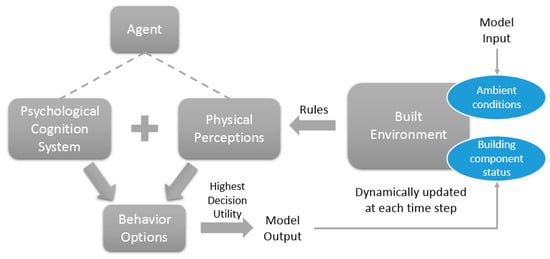
Figure 1.
Overview of the agent-based modeling (ABM) modules and decision-making process in PMFserv.
For the purpose of integrating with EnergyPlus™, the ABM was designed to execute on a time-step basis. Specifically, the occupant will conduct at most one behavior at each time step based on the surrounding conditions (i.e., environment and building component status). For example, at moment T, the door, window, and window blinds’ status are all closed, while the ambient conditions are updated with certain values. This information will be perceived by the agent under the programmed rules, thus may be triggering one or multiple physical perceptions including thermal and visual comfort, and air quality measures (e.g., the occupant may feel hot or that it is dark in the room). At the same time, the value system of the agent which is structured by weighted psychological items will evaluate the triggered perceptions and available behavior options, and calculate the decision utilities considering all the modules. At the end of the simulation step, the model outputs one or no action based on the highest decision utility and current building component status. For instance, the occupant may feel both hot and dark at the same time at moment T, but he or she will conduct the behavior that improves both the perceptual and psychological status the most at this time step. In general, the agent decides the behavior output based on the extent of unsatisfactory of that particular perception, under current built environment conditions and his or her own status.
It should be noted that unlike commonly used data-driven modeling methods, such as [30,31], the occupant behavior model in this study begins and ends from the individual’s perspective, and the behavior prediction is governed by rules instead of statistical inference. In other words, the ABM is not built upon collected data, but based on domain-related assumptions and regulated rules.
To validate the assumption and effect of the developed ABM, an exploratory study was conducted in the test-bed building. Related data of indoor and outdoor environmental parameters that are served as input of the ABM were collected, and actual behaviors of different individuals were recorded manually from five single-occupancy rooms. The actual data were then compared with simulation output from the ABM at individual and group levels to understand the model performance. Details of the validation study are available in [6]. As a follow-up study, this paper aimed at demonstrating the validity of the ABM to be applied for simulation coupling or further uses.
3.2. Coupled Simulation Mechanism
The development of the occupant behavior model aims to add the human dimension to building energy simulation program and, thus, has the potential to improve its overall simulation performance. Occupants in commercial buildings may adjust building systems, components, or devices to improve their indoor environmental conditions, to satisfy their thermal, visual, and air quality comfort requirements. However, the current building energy simulation programs lack the ability to capture these behavior changes. The goal of this simulation coupling framework is to integrate the occupant behavior model and the building energy simulation model in order to dynamically exchange information between the two simulators and to create a more realistic virtual environment for building energy estimation.
The concept of co-simulation meets the research goal. In short, both PMFserv and EnergyPlus™ execute on a time-step basis. Therefore, the integration process can be achieved by exchanging designated outputs to serve as inputs to the other simulation engine. Specifically, the occupant behavior model takes several input variables from EnergyPlus™, including temperature (indoor and outdoor), relative humidity (indoor and outdoor), CO2 concentration, illumination, and occupancy at zone level, and outputs the building components status (i.e., window, door, and window blinds) under the current condition. EnergyPlus™ receives the status of the three building components from the occupant behavior model, and computes the environmental conditions for the next time step. BCVTB was used to connect the two simulation engines by establishing direct links to both ends, so that the simulation process can be executed automatically with a user-defined simulation period and time step. It is noted that the coupling of the two engines was not hard-coded. Instead, any other occupant behavior models or building energy models that are developed based on the two engines can be loaded to enable the co-simulation execution. This increases the flexibility of the framework for further uses.
The implementation of the co-simulation framework not only supplements an additional module for building energy simulation, but also accounts for dynamic influence brought by building occupant behaviors. Figure 2 depicts the input/output exchange mechanism in a general view. Initially, the status for all three building components were set as “closed”. During the simulation process, the building component status was only assumed open or close without a detailed extent setting such as the opening angles.
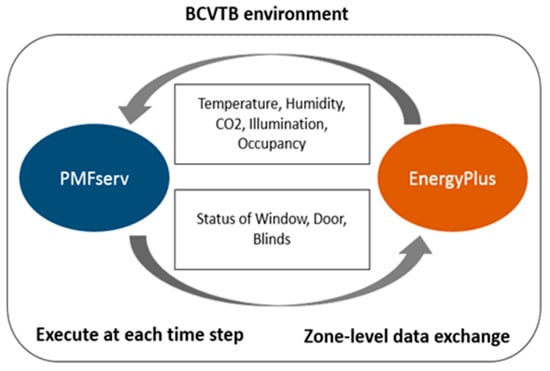
Figure 2.
Coupled simulation of PMFserv and EnergyPlus™.
3.3. Case Study
With co-simulation implemented, EnergyPlus™ is able to exchange information with the occupant behavior model, so that a dynamic behavioral schedule will be used for pertinent parameters calculation. To examine the framework, a case study was conducted. Five rooms of the building (same as the validation study sample rooms) were selected to run the coupled simulation. Ideally, with the additional module that accounts for occupant influences on building energy use, the simulated result by EnergyPlus™ would be closer to the measured energy use for the target building. However, since the coupled simulation was only executed in a small portion of the building, the building energy estimation may not represent the situation of the entire building. Nevertheless, it is still meaningful to compare the simulation results with and without coupling the occupant behavior model. The purpose was to investigate the impact of occupant behaviors on building energy use, so that further extensive analysis can be conducted to improve simulation accuracy and design realistic energy management solutions. In general, although the research experiment was performed for five selected rooms, the simulation results can be a starting point to improve building performance based on occupant behaviors’ patterns.
For the case study, a building energy model was developed in EnergyPlus™ based on the test building (Figure 3). The building is a typical educational building consisting of classrooms, offices, laboratories, etc. It is located in the state of Florida, USA, a subtropical climate zone. The simulation integration was conducted at the room level instead of the whole building level given the number of occupants in the study. The simulation period corresponded to the occupant behavior model validation time frame (i.e., four weeks from the end of February to the end of March 2018), which was in the middle of the spring season. In particular, the weather data used for simulation study was acquired from an online source [32] which provides a weather information file in EnergyPlus™ Weather (EPW) format for the designated period. Finally, the simulation time step was set to 15 min, corresponding to the occupant survey in the validation study [6].
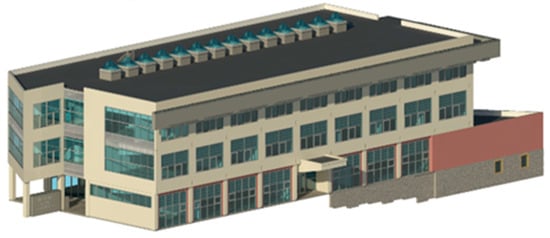
Figure 3.
Case study building in 3-D model.
To compare the simulation results, a baseline model for the case study building was developed and calibrated according to the reality. Since each co-simulation run was executed for a single room, five separate EnergyPlus™ models were generated upon the baseline model that incorporated the behavior patterns of each occupant, so that the individual influences to the building could be assessed. By analyzing the simulation results, insights were gained about how occupants react under different environmental conditions and how they cause energy use variation with their different behavioral patterns. Figure 4 shows the simulation experiment design, with the relationship between the baseline model and the ABM-based models.
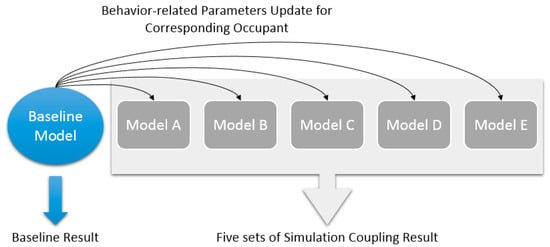
Figure 4.
Simulation experiment design for result comparison.
4. Simulation Results
4.1. Building Energy Use
The presented results are outputs from EnergyPlus™ for the default and co-simulation settings. The focus is to explore and compare the energy use-related factors with different occupant behavior information inputs.
For the four-week simulation experiment, the differences between baseline (i.e., with no occupant behavior) and the simulation integration (i.e., with occupant behavior models in site energy use) are compared at the building level, as the room/zone energy use data is unavailable. As shown in Figure 5, even though the behavior change was at the room-level, the total energy use difference at the building level can be observed. Moreover, the amount of variation differs for each occupant, due to the distinct built environment and zone location they were situated in. Considering that the simulation period was limited to approximately one month, the absolute differences can potentially be more significant for an annual simulation. Another aspect is that all the ABM-based cases had lower energy use than the default according to the simulation result. Since the environmental conditions, rather than energy use, drives how the agents (occupants) interact with the building components in the ABM, it is inferred that a higher level of indoor comfort and building energy efficiency can be achieved simultaneously. It also demonstrates the importance of involving dynamic and detailed occupant behavior information in the building simulation program. Last, but not least, in this study, although the studied behaviors did not include energy-consuming behaviors such as use of individual heaters and fans, the influences on energy use can help understand and analyze the behavior-energy links through extended experiments.
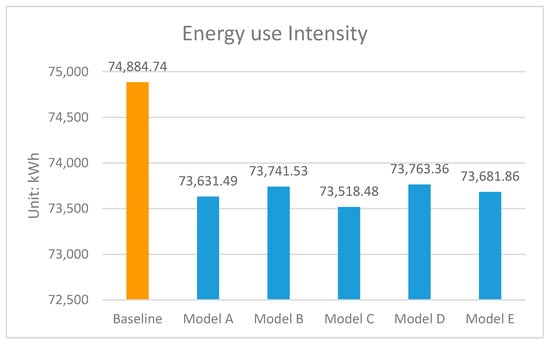
Figure 5.
Energy use intensity result at building level between baseline and ABM-based models. Note: The bottom value of the figure starts from 72,500 instead of 0, for a more observable comparison.
Room- and zone-level total energy use data is unavailable because there is no reliable or general way to assign a portion of the HVAC energy use to a particular zone. However, other energy-related results are accessible. In Table 1, two relevant zonal energy use types are shown. The results of ABM case for each occupant were extracted from the corresponding model (e.g., result of occupant A is from Model A, etc.). The first factor, namely Zone Air System Sensible Heating Energy, reports the total heating energy delivered by the HVAC system to a zone. It is to be noted that this does not always indicate the actual operation of heating coils. For example, outdoor air can contribute to the amount of heating in the spring season even if all coils are off. Nevertheless, the changes in the values are useful measures for comparison. As seen from the table, for the ABM-based scenario, the sensible heating energy for all zones increased while the cooling sensible energy showed a contrary direction. The results could guide building system design or future operation schedules, as the outside air can compensate for part of the energy output by the HVAC system. For Zone Total Internal Latent Gain Energy, the volumes decreased but the amount was subtle. It can be concluded that through the use of the window, door, and window blinds, the latent gains from people and internal equipment may be reduced, at least during the typical spring season in the building location.

Table 1.
Zone level simulated energy-related results by type for the baseline and ABM behavior cases for each occupant in the study.
4.2. Thermal Comfort
Besides the observation on the building side, it is also necessary to examine the comfort level on occupant side. In EnergyPlus™, thermal comfort condition can be extracted via the output of PMV, a thermal comfort measure, which values a thermal sensation metric according to the mean response of occupants. The values of PMV range from −3 to 3 including 0, with “0” being the most ideal or comfortable in terms of thermal comfort, and −3 and +3 representing very cold and very hot scenarios, respectively. In Table 2, the mean and variance of PMV in the simulation duration for the five occupants are listed. An interesting phenomenon can be observed for the coupled simulation scenario with the dynamic behavior change provided by ABM, where the mean PMV values for all five occupants moved away from the neutral value 0. This means on average, with the behavior being conducted, the occupant may feel colder, which does not meet the expected consequence. One of the possible reasons that lead to this result is because the ABM is not solely based on thermal conditions of the built environment, also considering visual comfort and air quality before making a decision. Under the simulation setting of the room, opening the window and door are the two options that both adapt to thermal and air quality conditions. It is inferred that there are many time periods that the occupant prioritized air quality issue and chose to open the window or door, although it might be thermally uncomfortable at the moment. Another possible explanation is the comfort range setting in the ABM might differ from the ASHRAE standard. In other words, for a general population, the environment is considered “cold” but for the modeled occupants, the environment may be in the tolerant range. Nevertheless, additional research must be performed to support the potential reasons mentioned.

Table 2.
Predicted mean vote (PMV) values comparison for baseline and ABM behavior cases for each occupant.
Although the explanations above need extensive research to prove the reliability, the simulation result of built environment comfort calls for the significance of involving standard parameters that measure other sensations in addition to thermal comfort level. Building energy modeling tools could benefit from a more comprehensive system to evaluate the building performance. Moreover, further research could focus on how building occupants prioritize their sensations under an uncomfortable built environment, and thus the building design can be more human-oriented.
4.3. Indoor Environment
Since occupant comfort index may not be able to reflect every single individual’s preference, the indoor environment parameters variation can provide more objective information of the building performance. Therefore, the temperature and carbon dioxide variation in the simulation period for one of the five rooms are depicted in Figure 6 and Figure 7, with the x-axis showing the hours within the period. It can be seen from Figure 6 that with the behavior information updated at each time step during simulation process, the fluctuation becomes slightly more apparent than the baseline model. The extreme values for the ABM-based case both exceed the original case, especially for the nadir of the trend. This complies with the PMV value change in Table 2, where the mean value decreased and the variance value increased for all the occupants. Temperature variation was mainly caused by window operation in the case study building, and since the outdoor temperature range was comparatively large in the spring season at the building’s location, indoor temperature was influenced to some extent.
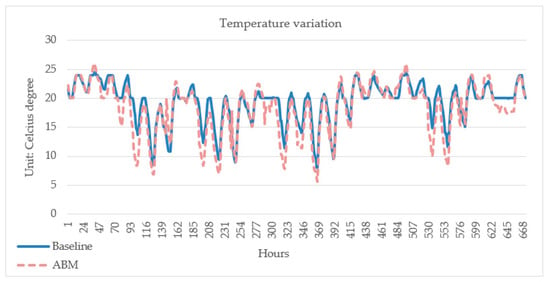
Figure 6.
Temperature variation of two simulation settings for one occupant in the simulation period.
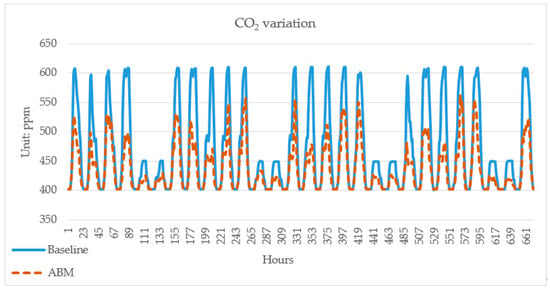
Figure 7.
CO2 variation of two simulation settings for one occupant in the simulation period.
However, the variation of CO2 showed a contrary situation (Figure 7). From the behavior output of the ABM, window and door were frequently opened for the occupant during the simulation. According to [33], 600 ppm is a generally acceptable CO2 level among most populations. Since the baseline model did not include any schedules for window and door operation, the CO2 level reached or exceeded 600 in certain time periods. In contrast, the ABM case showed a much lower value of the peak CO2 concentration during the one-month experiment. With the ventilation caused by window and door operation, the overall CO2 level was maintained at a more stable and comfortable range. This partially demonstrated our argument before, that the occupant may choose air quality over thermal comfort in the ABM virtual environment. Moreover, a lower CO2 level is a strong indicator of air quality improvement, which illustrated the building performance from another perspective. It is concluded that with the behavioral adaptation to the building component in the ABM scenario, indoor air quality is improved while the thermal condition is sacrificed, comparing to the baseline case.
5. Discussion
In summary, the simulation experiment in this study accomplished two research goals. First, it implemented the simulation coupling idea by running a co-simulation framework with EnergyPlus™ and PMFserv, and the applicability of the novel occupant behavior model was demonstrated. Second, through the comparison study for the two simulation scenarios, influences of occupant interactions with targeted building components were quantified and analyzed. The presented results can help building designers and engineers optimize a building’s mechanical or electrical systems, resulting in energy savings and a more comfortable indoor environment.
Further studies should include extending the simulation (i.e., simulate a whole year), to probe the seasonal differences among different behavior scenarios. The space covered in the study is also limited to only five out of more than 50 thermal zones, which could be expanded to the entire building. It is important to explore the averaging effect of occupant behaviors if more rooms or zones are included for simulation, as individual occupants’ impact on building performance at different spatial scales varies [34]. Moreover, one of the limitations of the developed ABM is the lack of uncertainties involved in the model. In other words, the model generated a deterministic output based on the corresponding input, which cannot fully reflect the stochastic nature of occupant behaviors. Sensitivity studies can be performed to delve into the relations between pertinent environment factors, occupant behavior options, and building energy use. Last but not least, those parameters in EnergyPlus™ that reflect behavioral changes should be revised by researchers or tool developers to capture the actual impact of behaviors more comprehensively.
The simulation results also suggest a lower energy use with occupant behavior information inputs for ABM scenario, which promotes feasible energy conservation solutions through human-in-the-loop building operation. The capability of accounting for the human dimension to building performance in a dynamic manner will benefit all the stakeholders of a building through informed decision-making.
6. Conclusions
This paper discussed a coupled simulation experiment that integrated an agent-based model of occupant behaviors and a building energy model created in EnergyPlus™. The occupant behavior model was developed based on an existing building and five single-occupancy offices were selected to validate the model. The model assumed the major driver of behaviors are environmental conditions, and thus three different perceptions of building occupant were modeled corresponding to the surrounded environment. The simulation study enabled a co-simulation framework of the ABM and the building energy model which can exchange data as input and output for each other at each time step, until the simulation ends. The analysis of simulation results was conducted from different perspectives to provide a comprehensive evaluation for building performance. The comparison between a baseline model and the coupled simulation models showed noticeable differences which can help building stakeholders understand occupants’ need better. The main findings are:
- Occupant behaviors influence building energy use from room level to building level. Even though the studied behaviors occur in the room level and do not consume energy directly, differences were observed from the baseline model and the simulation coupling models.
- Thermal comfort may not be the only factor that drives occupant’s adaptation to the environment. Standard metrics for other sensations are necessary to obtain a holistic performance evaluation approach.
- Occupant behaviors also caused built environment variation from various aspects. Occupants may choose to adjust to the indoor environment for their most concerned element regardless of others.
Future research may include extended and detailed research to validate the conclusions above, using measured energy use to investigate the simulation accuracy with the supplementary occupant behavior input, and testing the ABM and simulation integration function on multiple test bed buildings to expand the use of the proposed framework.
Author Contributions
M.J. designed and implemented the simulation experiment of this study, conducted the literature review, and drafted the paper. R.S. discussed results, and reviewed and finalized the manuscript. All authors have read and agreed to the published version of the manuscript.
Funding
This research received no external funding.
Acknowledgments
The authors would like to thank Robert Ries at University of Florida and Gnana Bharathy at University of Pennsylvania who provided valuable suggestions for this research.
Conflicts of Interest
The authors declare no conflict of interest.
References
- Gursel, I.; Sariyildiz, S.; Akin, Ö.; Stouffs, R. Modeling and visualization of lifecycle building performance assessment. Adv. Eng. Inf. 2009, 23, 396–417. [Google Scholar] [CrossRef]
- Mallory-Hill, S.; Preiser, W.F.; Watson, C.G. (Eds.) Enhancing Building Performance; John Wiley & Sons: Hoboken, NJ, USA, 2012. [Google Scholar]
- Yang, R.; Wang, L. Multi-agent based energy and comfort management in a building environment considering behaviors of occupants. In Proceedings of the 2012 IEEE Power and Energy Society General Meeting, San Diego, CA, USA, 22–26 July 2012. [Google Scholar]
- Department of Energy. About Building Energy Modeling. Available online: https://www.energy.gov/eere/buildings/about-building-energy-modeling (accessed on 4 April 2020).
- Yan, D.; O’Brien, W.; Hong, T.; Feng, X.; Burak Gunay, H.; Tahmasebi, F.; Mahdavi, A. Occupant behavior modeling for building performance simulation: Current state and future challenges. Energy Build. 2015, 107, 264–278. [Google Scholar] [CrossRef]
- Jia, M.; Srinivasan, R.S.; Ries, R.; Weyer, N.; Bharathy, G. A systematic development and validation approach to a novel agent-based modeling of occupant behaviors in commercial buildings. Energy Build. 2019, 199, 352–367. [Google Scholar] [CrossRef]
- Lawrence Berkeley National Laboratory. Building Controls Virtual Test Bed. Available online: https://simulationresearch.lbl.gov/bcvtb/FrontPage (accessed on 13 November 2018).
- Bharathy, G.K.; Silverman, B. Holistically evaluating agent-based social systems models: A case study. Simulation 2013, 89, 102–135. [Google Scholar] [CrossRef]
- Hopfe, C.J.; Hensen, J.L. Uncertainty analysis in building performance simulation for design support. Energy Build. 2011, 43, 2798–2805. [Google Scholar] [CrossRef]
- Hensen, J.L.; Lamberts, R. (Eds.) Building Performance Simulation for Design and Operation; Routledge: Abingdon, UK, 2012. [Google Scholar]
- Crawley, D.B.; Hand, J.W.; Kummert, M.; Griffith, B.T. Contrasting the capabilities of building energy performance simulation programs. Build. Environ. 2008, 43, 661–673. [Google Scholar] [CrossRef]
- Kumar, R.; Kaushik, S.C. Performance evaluation of green roof and shading for thermal protection of buildings. Build. Environ. 2005, 40, 1505–1511. [Google Scholar] [CrossRef]
- Yao, L.; Chini, A.; Zeng, R. Integrating cost-benefits analysis and life cycle assessment of green roofs: A case study in Florida. Hum. Ecol. Risk Assess. Int. J. 2018, 26, 443–458. [Google Scholar] [CrossRef]
- Komeily, A.; Srinivasan, R.S.; Salili, S.M.; Jákli, A.; Shahsavan, H. Application of wide-band liquid crystal reflective windows in building energy efficiency: A case study of educational buildings. In Proceedings of the 2016 Winter Simulation Conference (WSC), Washington, DC, USA, 11–14 December 2016; pp. 3213–3224. [Google Scholar]
- Anastasiadi, C.; Dounis, A.I. Co-simulation of fuzzy control in buildings and the HVAC system using BCVTB. Adv. Build. Energy Res. 2018, 12, 195–216. [Google Scholar] [CrossRef]
- Srinivasan, R.S.; Manoharan, B.; Issa, R.R.A. Urban Building Energy CPS (UBE-CPS): Realtime Demand Response using Digital Twin. In CPS in the Built Environment; Anumba, C.A., Roofigari, N., Eds.; Springer: Berlin/Heidelberg, Germany, 2020. [Google Scholar]
- Hong, T.; Yan, D.; D’Oca, S.; Chen, C.F. Ten questions concerning occupant behavior in buildings: The big picture. Build. Environ. 2017, 114, 518–530. [Google Scholar] [CrossRef]
- Fabi, V.; Andersen, R.V.; Corgnati, S.; Olesen, B.W. Occupants’ window opening behaviour: A literature review of factors influencing occupant behaviour and models. Build. Environ. 2012, 58, 188–198. [Google Scholar] [CrossRef]
- Langevin, J.; Wen, J.; Gurian, P.L. Including occupants in building performance simulation: Integration of an agent-based occupant behavior algorithm with Energy Plus. In Proceedings of the ASHRAE/IBPSAUSA Buidling Simulation Conference, Atlanta, GA, USA, 10–12 September 2014. [Google Scholar]
- Lee, Y.; Malkawi, A. Simulating human behavior: An agent-based modeling approach. In Proceedings of the 13th IBPSA Conference, Chambery, France, 26–28 August 2013. [Google Scholar]
- Hong, T.; D’Oca, S.; Turner, W.J.N.; Taylor-Lange, S.C. An ontology to represent energy-related occupant behavior in buildings. Part I: Introduction to the DNAs framework. Build. Environ. 2015, 92, 764–777. [Google Scholar] [CrossRef]
- Hong, T.; D’Oca, S.; Taylor-Lange, S.C.; Turner, W.J.N.; Chen, Y.; Corgnati, S.P. An ontology to represent energy-related occupant behavior in buildings. Part II: Implementation of the DNAS framework using an XML schema. Build. Environ. 2015, 94, 196–205. [Google Scholar] [CrossRef]
- Hong, T.; Sun, H.; Chen, Y.; Taylor-Lange, S.C.; Yan, D. An occupant behavior modeling tool for co-simulation. Energy Build. 2016, 117, 272–281. [Google Scholar] [CrossRef]
- Chen, Y.; Liang, X.; Hong, T.; Luo, X. Simulation and visualization of energy-related occupant behavior in office buildings. In Building Simulation; Tsinghua University Press: Beijing, China, 2017; Volume 10, pp. 785–798. [Google Scholar]
- Dziedzic, J.W.; Yan, D.; Sun, H.; Novakovic, V. Building occupant transient agent-based model–Movement module. Appl. Energy 2020, 261, 114417. [Google Scholar] [CrossRef]
- Gunay, H.B.; O’Brien, W.; Beausoleil-Morrison, I. Implementation and comparison of existing occupant behaviour models in EnergyPlus. J. Build. Perform. Simul. 2016, 9, 567–588. [Google Scholar] [CrossRef]
- Ouf, M.M.; O’Brien, W.; Gunay, H.B. Improving occupant-related features in building performance simulation tools. Build. Simul. 2018, 11, 803–817. [Google Scholar] [CrossRef]
- Lindner, A.J.M.; Park, S.; Mitterhofer, M. Determination of requirements on occupant behavior models for the use in building performance simulations. Build. Simul. 2017, 10, 861–874. [Google Scholar] [CrossRef]
- Silverman, B.G.; Bharathy, G.; Nye, B.; Eidelson, R.J. Modeling factions for “effects based operations”: Part I—Leaders and followers. Comput. Math. Organ. Theory 2007, 13, 379–406. [Google Scholar] [CrossRef]
- Haldi, F.; Robinson, D. Adaptive actions on shading devices in response to local visual stimuli. J. Build. Perform. Simul. 2010, 3, 135–153. [Google Scholar] [CrossRef]
- Yun, G.Y.; Steemers, K. Time-dependent occupant behaviour models of window control in summer. Build. Environ. 2008, 43, 1471–1482. [Google Scholar] [CrossRef]
- White Box Technologies. Available online: Weather.whiteboxtechnologies.com (accessed on 14 November 2018).
- Engineering ToolBox. Carbon Dioxide Concentration—Comfort Levels. 2008. Available online: https://www.engineeringtoolbox.com/co2-comfort-level-d_1024.html (accessed on 19 April 2020).
- Gilani, S.; O’Brien, W.O.; Gunay, H.B. Simulating occupants’ impact on building energy performance at different spatial scales. Build. Environ. 2018, 132, 327–337. [Google Scholar] [CrossRef]
© 2020 by the authors. Licensee MDPI, Basel, Switzerland. This article is an open access article distributed under the terms and conditions of the Creative Commons Attribution (CC BY) license (http://creativecommons.org/licenses/by/4.0/).